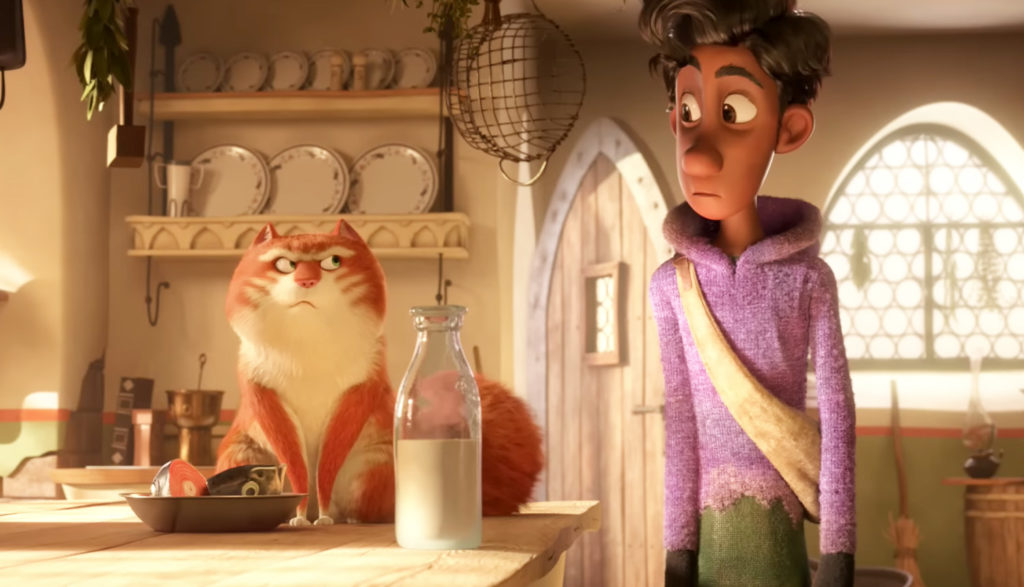
Don’t call him Morris. It’s Maurice, thanks ever so. He’ll tell you as much himself.
What? You ask how can Mor—er, Maurice tell you his name? You say that felines don’t talk? Well, this one can. Cat got his tongue, you might say.
But Maurice’s gift of tabby gab may be only the second-most remarkable thing about him. The first might be the fact that he hangs out with an equally loquacious company of rats.
Blame the denizens of Unseen University, who tossed out all manner of potions and spellbooks that the rats devoured (as rats do). Soon, this pack of rodents became sentient—not only able to talk, but to read and think and (in one notable case) wear top hats and dance. As for Maurice—well, he hung out in the same magical junkpile. Perhaps (he’ll tell you, with just a hint of evasiveness) that just being in proximity to all these smart rats made him smarter, too.
But naturally, a heap of rubbish is no place for smart, sentient animals, no matter how magical it might be. So they left the Unseen University and now travel the land—swindling people out of their money.
The scheme is simple. The rats invade a town. The townspeople panic. Maurice introduces said townspeople to a mystical Pied Piper-like character named Keith (a decent-but-not-particularly-creative human), who promptly brandishes his pipe and leads these apparently charmed rats out of town. Deliriously happy townspeople shower Maurice and Keith with money. And then, off they go to the next town.
It’s a good gig, as far as it goes. Or at least it had been.
But there’s something a little odd about the newest township they’ve come to swindle. First, it seems completely bereft of food. The townspeople assume there’s already a massive rat problem, because how else to explain where all the pumpernickel goes?
But in investigating the city’s sewers, Maurice and company discover odd thing number two: It would seem there aren’t any rats, either. Not that Maurice and his sharp-toothed friends can sniff out, at any rate. And the town is already hosting a pair of swarthy-looking rat-catchers and their mysterious, big-hatted boss.
Could it be that these folks have their own swindle going on?
No, something doesn’t smell right about this situation. In fact, it smells downright … ratten.
Rats rarely get to be the heroes in stories, be they magic or no. But these rats aren’t just smart: They’re reasonably moral, too. Perhaps we can thank Dangerous Beans for that.
Dangerous Beans is the rats’ de facto spiritual leader, and he questions the morality of tricking humans out of their hard-earned coin. (Maurice, naturally, disagrees. “Trickery is what humans are all about!” the cat insists.) Dangerous Beans would like to live in harmony with humankind, and he has a deep affection for the rodents in his care. He is, indeed, willing to risk his life for them.
This sort of sacrificial aplomb is wildly unusual for rats in general, but not for this group of intelligent rodents. They are, in many respects, an extended family—with each working in his or her own way for the betterment of others in the community.
Maurice, being a cat, has no such altruistic notions. Except that, maybe deep down under his orange fur coat, he does. And when Maurice’s own sacrificial tendencies well up, he’s just as surprised as anyone. He sacrifices a great deal for what would be, for most cats, simply a talkative meal.
Pipe-player Keith is fairly instrumental (get it?) in the good turns this story takes, too. He and a newfound friend, Malicia, dive into the mystery of the missing food/rats with enthusiasm, eventually braving a deep, dark forest to retrieve a magical item that they hope will save the day.
Let’s go back to Dangerous Beans. He is, as mentioned, the spiritual leader of the rats, and The Amazing Maurice stresses his religious nature. Indeed, he walks about with a shepherd’s crook (a symbol of Christian spiritual leadership) and teaches his flock out of a “sacred book”—in this case, Mr. Bunnsy Has an Adventure. It’s a Peter Cottontail sort of story, but what Dangerous Beans takes from it is the concept of an “ideal land where animals talk and live side by side with people in peace,” and where “nothing truly bad ever happens.”
Maurice claims (for his own malicious ends) to have known people who’ve been to the land of Mr. Bunnsy. But when the proverbial cat gets out of the bag that the land is fictional, some rats react as if their faith has been obliterated. Dangerous Beans tries to rally them behind a new vision—that if they stick together, they can work to build such a world—but it’s a more difficult sell.
While Mr. Bunnsy’s land is suggested to be fictional, The Amazing Maurice does give a nod to a potential afterlife of sorts—or, at least, some sort of blank netherworld between life and death. A character meets with both the Grim Reaper and his more diminutive rat companion (the Grim Squeaker, also decked out in black and carrying a tiny scythe) there. In one case, death is mystically reversed.
Keith is smitten with Malicia almost immediately. Malicia, meanwhile, is more enamored with the building blocks of stories, and initially dismisses Keith because of the sort of story she feels like she’s in. “You’re not handsome enough to be a love interest, and you’re not funny enough to be comic relief,” she tells him. “Maybe you’re a sympathetic friend to serve as a sounding board.”
Later, Malicia seems to warm up to Keith. But she laments that he doesn’t seem to have another love interest anywhere. If he did, there might be hope for their relationship yet. “Love complications,” she says. “Every story needs them. [But] since there isn’t anyone else, I’m not that girl.”
Turns out, she is that girl. The two end up kissing, both on the cheeks and on the lips.
The Amazing Maurice can be surprisingly intense for a PG movie. While we don’t see a lot of violence, we hear about it—and young imaginations might fill in the gaps.
We see, for example, a scene involving (the real-life activity of) rat-baiting: Rats are dropped in a small, circular pen and chased by a dog while spectators bet on how long the dog takes to kill them. Audiences will see a ravenous dog and some terrified rats before the camera swings away. We see, instead, some sentient rat characters watch the atrocity with horror. A couple of sentient rats do wind up in the rat pit with a dog, and one fights with it—eventually knocking the pooch senseless. (The rumble sparks a wider fight among the human gamblers, and we see several strewn the ground, bloodied and unconscious.)
Keith and Malicia meet the real Pied Piper, who “plays” a living turkey straight into an oven to cook it. When they ask if he really stole away a town full of children, the Piper’s deeply disturbing laugh tells them all they need to know. The movie suggests that he cooked those children, too—because he tries to do the same with Keith and Malicia. (They’re not cooked, but the Piper singes his own behind before falling down into a well.)
We see cartoony skeletons of rats, at least one of which was poisoned. An evil entity envelops rats into itself, and it’s insinuated that those not strong enough to join with the entity are killed. A character or two lose their lives, and several non-sentient rats are struck down. We see plenty of slapstick violence. Keith pretends to lure rats to their death via his “magic” pipe. Maurice, despite being on friendly terms with rats, still has a hankering to eat them, and we see that frightening desire a couple of times.
None.
None.
A character tricks a couple of people into eating food laced with laxatives. She tells the two victims that she poisoned them, then gives them more laxatives as an “antidote.” We hear some flatulent noises in the aftermath.
Food is stolen. Rats and cats alike work to trick humankind. And Maurice has his own somewhat malicious schemes going on, too. We see some congealed milk slide, like gelatin, out of a bottle.
On the most superficial level, The Amazing Maurice is a cute, clever, somewhat darkish cartoon that gives us a nice twist on your standard fairy tale. We’re introduced to a pack of charismatic rats and their underhanded feline friend. Together (with a couple of humans thrown in for good measure), they free a town from a creepily evil force. Characters (both human and animal) dig deep within themselves to find the strength and sacrifice needed to save the day. And while the story might definitely disturb some young ‘uns, there’s not a lot of problematic content that might sully the party otherwise.
But dig just a wee bit deeper, and you uncover some other elements that might be worth a pause.
The Amazing Maurice is based on the book The Amazing Maurice and His Educated Rodents, written by the famed author Terry Pratchett. It’s part of his sprawling Discworld series (the 28th book in that series, in fact), and the first one he wrote for kids. Before his death, Pratchett described himself as an atheist and a humanist, and his humanistic philosophy stands front-and-center in The Amazing Maurice.
The story pokes a bit of fun at the Bible with Mr. Bunnsy Has an Adventure and ridicules the idea of heaven. When the Mr. Bunnsy book is revealed as fiction, Dangerous Beans insists that there’s still validity in its ethical teachings. “The book is not what matters!” He shouts. “It’s what we make of it!”
Christians, of course, would say the book matters very much indeed.
Perhaps we should be gratified. Dangerous Beans—Mr. Bunnsy’s principled prophet—is the most virtuous, ethical character we meet. The Amazing Maurice may not cotton to religion, but this is no angry anti-religious scree. And certainly, one could potentially sidestep the movie’s humanist message and treat the thing as, again, a rather clever fairy tale.
Still, the echo is there. And certainly, there’s a potential that the movie might inspire discussion and questions from its young viewers. So for some parents, Beans might not be the only thing dangerous here.


Paul Asay has been part of the Plugged In staff since 2007, watching and reviewing roughly 15 quintillion movies and television shows. He’s written for a number of other publications, too, including Time, The Washington Post and Christianity Today. The author of several books, Paul loves to find spirituality in unexpected places, including popular entertainment, and he loves all things superhero. His vices include James Bond films, Mountain Dew and terrible B-grade movies. He’s married, has two children and a neurotic dog, runs marathons on occasion and hopes to someday own his own tuxedo. Feel free to follow him on Twitter @AsayPaul.